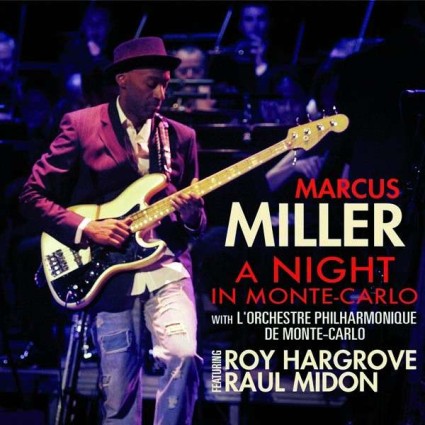Marcus Miller | A Night In Monte-Carlo
Marcus Miller | A Night in Monte-Carlo
By Peggy Oliver
Marcus Miller has worn many musical hats through his established career. Besides being one of the most in-demand studio musicians, especially for Luther Vandross, David Sanborn and Miles Davis, Miller is one of the master bass guitar technicians. From the slap style to gorgeous melodic washes, Miller has furthered the cause for contemporary urban bass players; certainly through the inspirations of other bass greats Stanley Clarke and Jaco Pastorius. But there is much more to his multi-gifted musician. Miller is a proficient multi-instrumentalist with the bass clarinet and keyboards. His production savvy and instrumental skills have graced many R&B and jazz recording sessions, which has won him numerous Grammy awards. And the longevity of Miller’s career is a testament to his devotion to making music in various urban formats. While playing with Davis, he wrote or co-wrote and produced the soundtrack for Siesta (1987) plus arranged and wrote almost all tracks for the whirlwind project (from go-go to zouk to swing jazz), Amandla in 1988. His funky and rumbling R&B bass lines played a huge role on several Vandross’ recordings (“Never Too Much,” “Power of Love,” “Dance with My Father”) until the R&B superstar’s death in 2007. His collaboration with Sanborn lasted twenty-five years from 1975 to 2000, including two Grammy winning discs Voyeur and Inside. Then there is the power bass guitar triumvirate of Miller, Clarke and Victor Wooten, who teamed in 2008 for Thunder under the moniker SMV.
At times, jazz purists would criticize Miller for incorporating too much high tech like drum machines and sampling. Yet he was not afraid to utilize the technology as long as the musicianship was credible. But no one could dispute Miller’s attention to improvisation and innovations that continued to stretch the boundaries of modern jazz music during his
solo concerts. His latest project takes him to A Night in Monte-Carlo (recorded in 2008), accompanied by his Davis’ ensemble (Federico Gonzalez Pena on keyboards and percussion, horn player Alex Han and drummer Poogie Bell) and L’Orchestre Philharmonique de Monte-Carlo. The integration of orchestral arrangements with jazz musicians is not exactly a revelation (think most of the Miles Davis and Gil Evans as a prime example). But Miller’s extensive knowledge of fusion music and his association with Davis certainly fuel a lot of the material on A Night in Monte-Carlo.
Tracks:
The bouncy opening – Blast! – is an oriental slanted extravaganza with fluid bass guitar lines meshing with the orchestra on the melody. A glorious alto sax solo by Alex Han follows mid way before segueing into a turntable solo by DJ Logic (instantly jogging memories of Herbie Hancock’s “Rock It”) and Miller turning on the popping the bass jets for the climax.
Who could imagine a Miller concert without Miles’ jazz masterpiece – So What? Davis’ trademark bop classic from the late fifties receives a funkier edge and pays much respect to Davis as this arrangement includes the original Bill Evans’ intro.
A phenomenal vocalist and guitarist in his own right, guest Raul Midon takes over the show on “State of Mind” (also the title track of Midon’s solo disc from 2005), executing a pretty mean mouth trumpet while playing guitar.
Not everything is funky jazz fresh on A Night in Monte-Carlo. “I Loves You Porgy” from George & Ira Gershwin’s opera Porgy & Bess finds Miller bringing out his fretless bass guitar to explore his more melodic and gentle side. His interaction with the orchestra and Han adds more tenderness to this haunting romantic ode.
Miller steps aside and lets the horn section explore their solo territory on “I’m Glad There Is You,” especially multi-dimensional jazz trumpeter Roy Hargrove, who reinterpreted this big band hit by Jimmy Dorsey on his Moment to Moment disc.
The Miller composition, “Amandla”, written for Davis, successfully molds modern jazz and orchestra. The horns come through once again as Han oozes a soulful underpinning on sax and Hargrove’s dynamic trumpet reflects Davis’ colorful imprint.
The Medley: “O Mio Babbino Caro (Oh My Dear Papa)” & “Mas Que Nada” goes from one extreme to another. First, there is an excerpt from one of Giacomo Puccini signature operatic arias sensitively played by Miller, and then Midon’s vocals rips into a Jorge Ben samba favorite – also a smash hit for Sergio Mendes’ & Brasil 66.
“Your Amazing Grace,” a classic soul reconstruction of Amazing Grace, took awhile to grow on me but Middon’s vocal fills and Miller on bass clarinet reflected an impressive musical diversity of A Night in Monte-Carlo.
The closing piece is a studio track as pianist Hancock accompanies Miller playing a melancholy bass clarinet for Billie Holliday’s equally dark themed, “Strange Fruit.”
Those are all the aforementioned reasons why this Night in Monte-Carlo was an electric night for jazz and orchestra musicians who were all clicking, and an enthusiastic audience who was treated to a special night indeed.
Peggy Oliver
The Urban Music Scene
